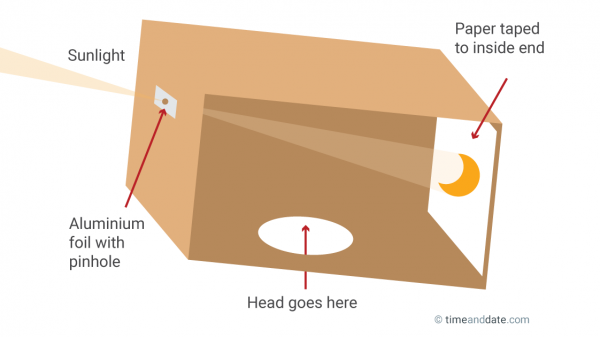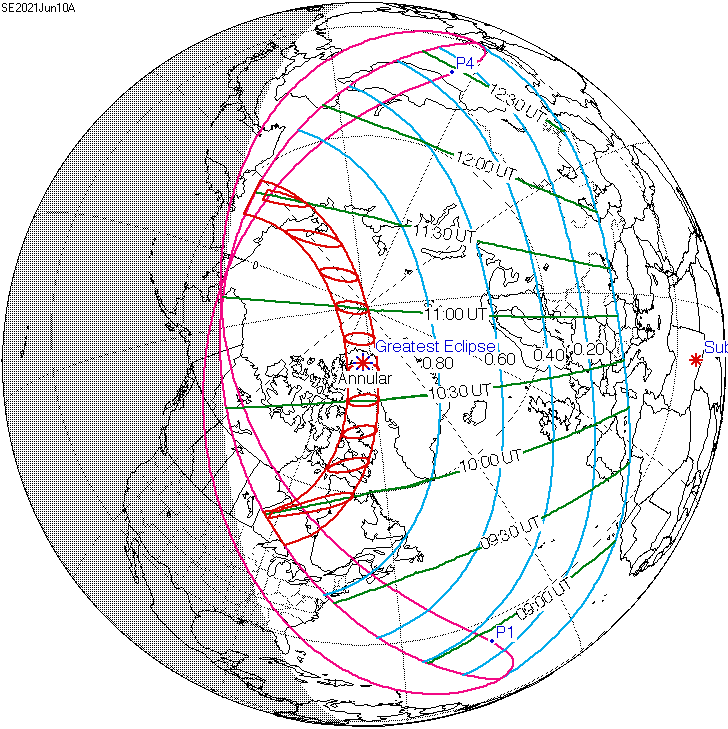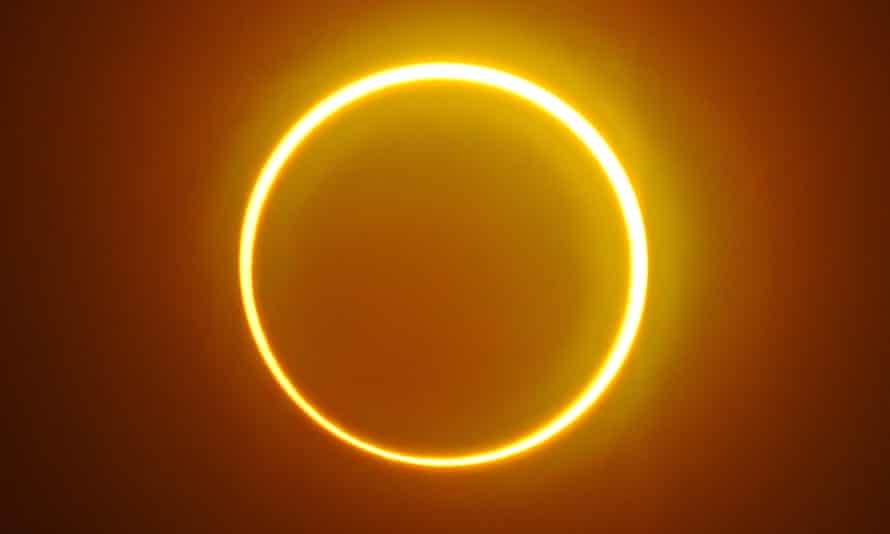THE SOUTHWORTH PLANETARIUM
207-780-4249 www.usm.maine.edu/planet
70 Falmouth Street Portland, Maine 04103
43.6667° N 70.2667° W
Altitude: 10 feet below sea level
Founded January 1970
Julian Date: 2459367.18
2020-2021: CXL
THE DAILY ASTRONOMER
Wednesday, June 2, 2021
Partial Solar Eclipse!
So, I changed my mind. I intended to post part II of the June Night Sky Calendar today. Instead, however, today's article will focus solely on the partial solar eclipse WE will see on Thursday, June 10th, weather permitting, of course. We have found that the Question/Answer format works quite well for such events, and so we'll use it today.
WHEN WILL WE SEE THE ECLIPSE?
Literally at sunrise. On Thursday, June 10th, the Sun will rise at 4:59 a.m. At that time, the moon will be covering about 50% of the Sun's disc. The obscuration will increase during the next half hour. By 5:30 a.m. the Sun will be 74% obscured here in Portland, Maine. The moon will then slowly move away from the Sun until last contact around 6:30 a.m.
WILL WE NEED SPECIAL PROTECTIVE GLASSES TO SEE THIS ECLIPSE?
Absolutely! It is NEVER safe to look at the Sun even during a partial eclipse. An eclipse can only be safely observed during totality, when the moon completely blocks the Sun's disc.
Absolutely! It is NEVER safe to look at the Sun even during a partial eclipse. An eclipse can only be safely observed during totality, when the moon completely blocks the Sun's disc.
DO YOU SELL ECLIPSE GLASSES?
Darn it, we'd love to say "yes," but we have to say "no." We were closed for thirteen months during the ____________* and so didn't have any funds with which to purchase such glasses.
Darn it, we'd love to say "yes," but we have to say "no." We were closed for thirteen months during the ____________* and so didn't have any funds with which to purchase such glasses.
HOW WILL IT BE ABLE TO WATCH IT, THEN, YOU JERK?!
Well, since you asked so nicely.....you can make your own eclipse viewer!
1. Find a cardboard box. Cut a hole on one side of it and cover that hole with aluminum foil. Puncture the foil with a SMALL hole. (Making it larger will make the image too diffuse.)
2. Place a piece of white paper inside the box on the side opposite the one where you placed the aluminum foil. This paper will serve as the projection screen.
3. You can cut a hole in the box bottom through which you can insert your head. OR, you can just cut the bottom of the box out completely. You place the box over your head and direct the foil toward the Sun. When the sun's light is aligned with the hole, its image will be projected onto the white "screen"

An image of the completed homemade projection theater. By the way, we have a great deal more respect for your intelligence than the person responsible for this graphic. We suspect you know where the head should go.
WELL, I DON'T LIVE IN THE PORTLAND AREA. WILL I SEE THE ECLIPSE AND IF SO, WHEN?
Refer to the map below. If you live in an area that is within the eclipse "loop grid" below, you will either see a partial eclipse or the annular eclipse.
The annular eclipse is only visible to those within the eclipse path marked by red ovals.

Observers in the northeastern United States and Canada will see a partial solar eclipse. To determine the times and obscuration percentages in your area, consult the web-site www.timeanddate.com/eclipse/solar/2021-june-10
We can see that the partial eclipse will be visible in northern parts of Europe and Asia. The boundary runs almost exactly along the Strait of Gibraltar.
WHAT IS AN ANNULAR ECLIPSE AGAIN?
An annular eclipse is a solar eclipse that occurs when the moon is at or near apogee, its point of greatest distance from the Sun. The moon will therefore appear smaller in our sky than the Sun and so will not block it entirely during the eclipse. The word "annular" derives from the Latin word "annulus," meaning ring. The moon will reach apogee on June 8th, two days before the eclipse.
An annular eclipse is a solar eclipse that occurs when the moon is at or near apogee, its point of greatest distance from the Sun. The moon will therefore appear smaller in our sky than the Sun and so will not block it entirely during the eclipse. The word "annular" derives from the Latin word "annulus," meaning ring. The moon will reach apogee on June 8th, two days before the eclipse.

An annular eclipse occurs when the moon doesn't completely block the Sun during an eclipse. We will NOT see the annular eclipse here in southern Maine.
*We're so tired of hearing about the you-know-what that we can't bear to even write it down.
To subscribe or unsubscribe from the Daily Astronomer: